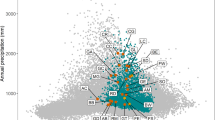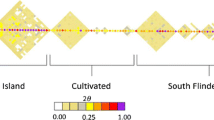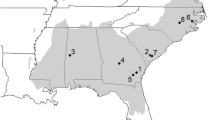Summary
An experimental design is presented for estimating genetic parameters using a family structure with clonally replicated individuals. This experimental design provides a technique to quantify genetic variation in a population, with partial separation of additive, dominance and epistatic gene action. Our method is offered as an alternative to techniques for estimating epistatic gene action that require several generations and/or inbreeding. Such methods are not particularly useful for long-lived perennials with long generation cycles. An example of the analysis is given with a forest tree species, Populus deltoides Bartr., and parameter estimates are presented for traits measured over 8 years.
Similar content being viewed by others
References
Atchley WR (1984) Ontogeny, timing of development, and genetic variance-covariance structure. Am Nat 123:519–540
Becker WA (1984) Manual of quantitative genetics, 4th edn. Academic Enterprises, Pullman/WA
Burdon RD, Shelbourne RD (1974) The use of vegetative propagules for obtaining genetic information. NZ J For Sci 4:418–425
Burton GW, DeVane EH (1953) Estimating heritability in tall fesque (Festuca arundinacea) from replicated clonal material. Agron J 45:478–481
Cochran WG (1951) Testing a linear relation among variances. Biometrics 7:17–32
Cockerham CC (1954) An extension of the concept of partitioning hereditary variance for analysis of covariance among relatives when epistasis is present. Genetics 39:859–882
Cockerham CC (1961) Estimation of genetic variances. In: Hanson WD, Robinson HF (eds) Statistical genetics and plant breeding. Proc Natl Acad Sci Natl Res Council USA 982: 53–94
Comstock RE, Kelleher T, Morrow EB (1958) Genetic variation in an asexual species, the garden strawberry. Genetics 43:634–646
Cooper DT, Ferguson RB (1977) Removal of competition bias from forest genetics experiments. Proc 14th South For Tree Imp Conf, pp 70–77
Cooper DT, Randall WK (1973) Genetic differences in height growth and survival of cottonwood full-sib families. Proc 12th South For Tree Imp Conf, pp 70–77
Falconer DS (1960) Introduction to quantitative genetics. Ronald Press, New York
Farmer RE (1970) Genetic variation among open-pollinated progeny of eastern cottonwood. Silvae Genet 19:149–151
Farmer RE, Wilcox JR (1966) Variation in juvenile growth and wood properties in half-sib cottonwood families. In: Joint Proc 2nd Genetics Workshop of Soc Am For and 7th Lake States For Tree Imp Conf; USDA For Ser Res Paper NC-6, pp 1–4
Foster GS (1985) Genetic parameters for two eastern cotton-wood poulations in the lower Mississippi Valley. Proc 18th South For Tree Imp Conf, pp 258–266
Foster GS, Campbell RK, Adams WT (1984) Heritability, gain, and C effects in rooting of western hemlock cuttings. Can J For Res 14:628–638
Hallauer AR, Miranda JB (1981) Quantitative genetics in maize breeding. Iowa State Universtity Press, Ames/IA
Hamblin J, Rosielle AA (1978) Effect of intergenotypic competion on genetic parameter estimation. Crop Sci 18:51–54
Keller KR, Likens ST (1955) Estimates of heritability in hops, Humulus lupulus. Agron J 47:518–521
Libby WJ (1962) Estimation of variance components of internode length in a cloned population of Mimulus guttatus. Genetics 47:769–777
Libby WJ, Jund E (1962) Variance associated with cloning. Heredity 17:533–540
Mather K, Jinks JL (1977) Introduction to biometrical genetics. Cornell University Press, New York/NY
McKnight JS (1970) Planting cottonwood cuttings for timber production in the South. USDA For Ser Res Paper S0-60, 17 pp
Mohn CA, Krinard FM (1971) Volume tables for small cotton-woods in plantations. USDA For Ser Res Note SO-113, 4 pp
Mohn CA, Randall WK (1973) Interaction of cottonwood clones with site and planting year. Can J For Res 3:329–332
Namkoong G (1979) Introduction to quantitive genetics in forestry. USDA For Ser Tech Bul No. 1588, 342 pp
Nance WL, Land SB, Daniels RF (1983) Concepts for analysis of intergenotypic competition in forest trees. Proc 17th South For Tree Imp Conf, pp 131–145
Searle SR (1971) Linear models. Wiley, New York/NY
Shaw DV, Hood JV (1985) Maximizing gain per effort by using clonal replicates in genetic tests. Theor Appl Genet 71:392–399
Stonecypher RW, McCullough RB (1986) Estimates of additive and non-additive genetic variance from a clonal diallel of Douglas-fir Pseudotsuga menziesii (Mirb.) Franco. In: Proc Int Union For Res Org, Joint Mtg Working Parties Breed Theor, Prog Test, Seed Orch. Williamsburg/VA. Publ by NCSU-Industry Coop Tree Imp Pgm, pp 211–227
Wilcox JR, Farmer RE (1968) Heritability and C effects in early root growth of eastern cottonwood cuttings. Heredity 23:239–245
Ying CC, Bagley WT (1976) Genetic variation of eastern cotton-wood in an eastern Nebraska provenance study. Silvae Genet 25:67–73
Author information
Authors and Affiliations
Additional information
Communicated by PMA Tigerstedt
Rights and permissions
About this article
Cite this article
Foster, G.S., Shaw, D.V. Using clonal replicates to explore genetic variation in a perennial plant species. Theoret. Appl. Genetics 76, 788–794 (1988). https://doi.org/10.1007/BF00303527
Received:
Accepted:
Issue Date:
DOI: https://doi.org/10.1007/BF00303527




